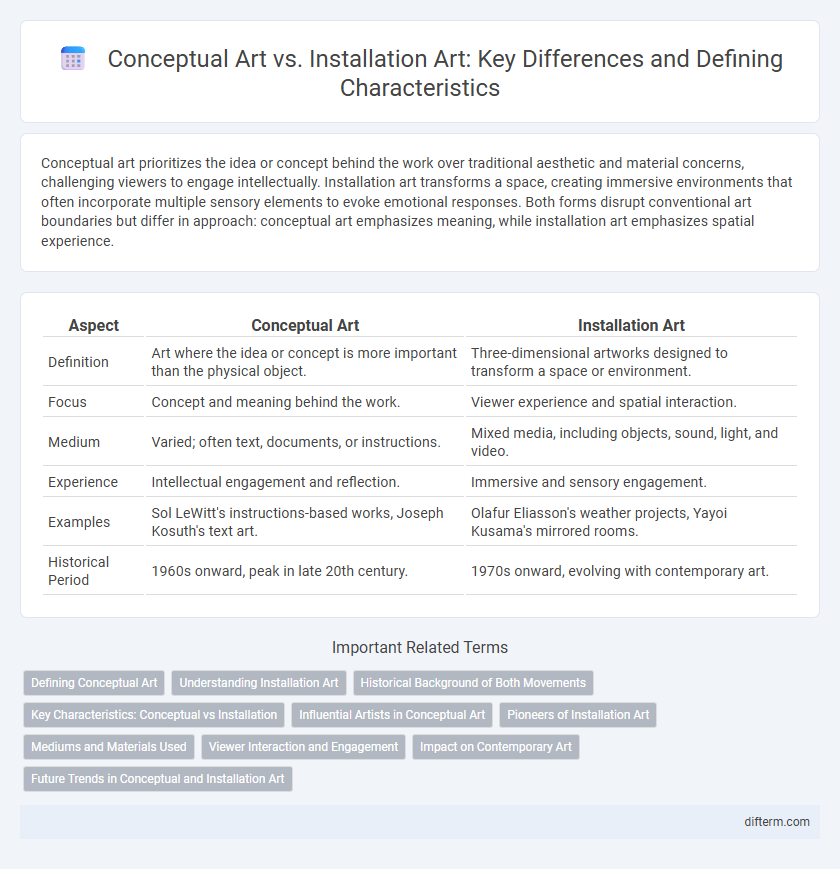Conceptual art prioritizes the idea or concept behind the work over traditional aesthetic and material concerns, challenging viewers to engage intellectually. Installation art transforms a space, creating immersive environments that often incorporate multiple sensory elements to evoke emotional responses. Both forms disrupt conventional art boundaries but differ in approach: conceptual art emphasizes meaning, while installation art emphasizes spatial experience.
Table of Comparison
| Aspect | Conceptual Art | Installation Art |
|---|---|---|
| Definition | Art where the idea or concept is more important than the physical object. | Three-dimensional artworks designed to transform a space or environment. |
| Focus | Concept and meaning behind the work. | Viewer experience and spatial interaction. |
| Medium | Varied; often text, documents, or instructions. | Mixed media, including objects, sound, light, and video. |
| Experience | Intellectual engagement and reflection. | Immersive and sensory engagement. |
| Examples | Sol LeWitt's instructions-based works, Joseph Kosuth's text art. | Olafur Eliasson's weather projects, Yayoi Kusama's mirrored rooms. |
| Historical Period | 1960s onward, peak in late 20th century. | 1970s onward, evolving with contemporary art. |
Defining Conceptual Art
Conceptual art emphasizes ideas over visual components, prioritizing the artist's message rather than aesthetic appeal. It often utilizes text, instructions, or documentation to convey meaning, challenging traditional art forms. Installation art, by contrast, is spatial and immersive, creating physical environments that engage viewers in sensory experiences.
Understanding Installation Art
Installation art transforms space through immersive environments that engage viewers physically and emotionally. Unlike conceptual art, which prioritizes ideas and intellectual engagement, installation art emphasizes sensory experience and spatial interaction. Artists such as Yayoi Kusama and Olafur Eliasson create installations that challenge perceptions and invite active participation within the constructed environment.
Historical Background of Both Movements
Conceptual art emerged in the 1960s, emphasizing ideas over traditional aesthetic and material concerns, with pioneers like Sol LeWitt and Joseph Kosuth challenging conventional art forms. Installation art developed slightly later, gaining prominence in the late 1960s and 1970s, focusing on creating immersive, site-specific environments that engage the viewer physically and spatially, with artists such as Christo and Jeanne-Claude leading the movement. Both movements arose as reactions against the commercialization and commodification of art, redefining artistic expression through intellectual engagement and experiential interaction.
Key Characteristics: Conceptual vs Installation
Conceptual art emphasizes ideas and concepts over traditional aesthetic and material concerns, often challenging conventional definitions of art through text, performance, or documentation. Installation art involves creating immersive, three-dimensional environments that transform a space, engaging viewers physically and emotionally within a specific context. Both forms prioritize experience and meaning, but conceptual art centers on intellectual engagement while installation art focuses on spatial interaction.
Influential Artists in Conceptual Art
Conceptual art challenges traditional art forms by emphasizing ideas over aesthetic objects, with influential artists such as Sol LeWitt, whose wall drawings illustrate instructions as art, and Joseph Kosuth, known for his exploration of language and meaning. Lawrence Weiner's text-based works further redefine art's physicality, highlighting communication as the artwork's essence. These artists collectively shift art's focus from material presence to intellectual engagement, distinguishing conceptual art from installation art's spatial and sensory experiences.
Pioneers of Installation Art
Pioneers of installation art, such as Allan Kaprow and Joseph Beuys, transformed traditional artistic boundaries by incorporating space and viewer interaction, emphasizing immersive experiences rather than static objects. Unlike conceptual art, which prioritizes ideas over physical form, installation art merges concept with environment to create a multisensory encounter. Their innovative approaches laid the foundation for contemporary art practices that challenge perception and redefine the role of the audience within the artwork.
Mediums and Materials Used
Conceptual art primarily emphasizes ideas and concepts over traditional aesthetics, often utilizing text, photography, and ready-made objects as mediums to challenge conventional art forms. Installation art involves immersive, site-specific environments created with diverse materials including found objects, video projections, sound, and sculptural elements to engage viewers spatially. Both mediums rely on unconventional materials but differ in that conceptual art centers on intellectual engagement, while installation art focuses on physical experience and spatial interaction.
Viewer Interaction and Engagement
Conceptual art prioritizes ideas over aesthetic form, often challenging viewers to interpret meaning through intellectual engagement rather than sensory experience. Installation art creates immersive environments that invite active physical participation, transforming the viewer from passive observer to integral part of the artwork. Both forms redefine traditional art boundaries by emphasizing viewer interaction, but installation art uniquely uses space and sensory stimuli to deepen engagement.
Impact on Contemporary Art
Conceptual art revolutionized contemporary art by prioritizing ideas over traditional aesthetics, challenging viewers to engage intellectually with the artwork's meaning. Installation art transformed spatial perception in galleries by creating immersive environments that actively involve the audience, enhancing sensory experience and emotional connection. Together, these movements expanded artistic boundaries, fostering innovation and interdisciplinary approaches in contemporary art practice.
Future Trends in Conceptual and Installation Art
Future trends in conceptual and installation art emphasize immersive experiences that integrate augmented reality (AR) and virtual reality (VR) technologies, expanding audience engagement beyond physical boundaries. Artists increasingly use interactive digital platforms to challenge traditional notions of space, materiality, and viewer participation, reflecting a shift towards multisensory and participatory art forms. Environmental themes and sustainability practices also shape emerging works, promoting ecological awareness through innovative, site-specific installations.
conceptual art vs installation art Infographic

 difterm.com
difterm.com